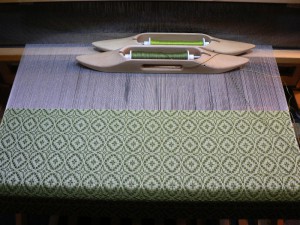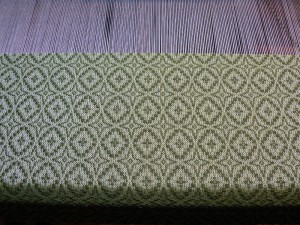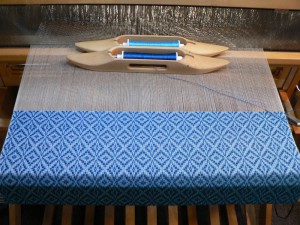I wove some cloth! This shouldn’t be so remarkable, I suppose, but I’ve been really unproductive in the fiber art realm lately so it’s big news. Ultimately I plan to use this cloth to make a new batch of books with purple covers. I had hoped to have a few made in time for the upcoming “Purple Show” at the Shelburne Arts Co-op, but alas they will not be ready in time. I may get them finished before the end of the show…. The show hangs this Tuesday March 31st, and is up until Monday April 27.
Here are the weaverly details about this project: The warp is 20/2 cotton, from the discontinued UKI line. (12/27/2023 Edited: The UKI link is no longer useful if you’re looking for weaving yarns, but I left it anyway.) The color is called Malay Purple. There are 598 ends in the warp. The sett is 30 ends per inch. The width in the reed is 20 inches. My draw-in (how much the edges pulled in as I wove) was about 6% and the shrinkage in the width was about 4%. Shrinkage in length was about 6%. I washed it by hand in hot water and hung to dry.
The pattern is a miniature overshot motif called Maltese Cross. I’ve written about overshot in earlier posts, but I’ll quickly recap here. To weave overshot, you typically weave one pick of fine yarn (the same size as the warp) alternating with one pick of thicker yarn (approximately twice the diameter of the warp). The fine yarn makes a background that stabilizes the cloth creating a plain weave structure called tabby. In this piece of cloth, I used the same color of 20/2 cotton for the warp and the tabby. The thicker weft yarns float over several warp ends and form the pattern. I’ve woven most of my book cloth using overshot motifs. I really love them. To me they are simultaneously old-fashioned and psychedelic. Continue reading “Purple Cloth”




